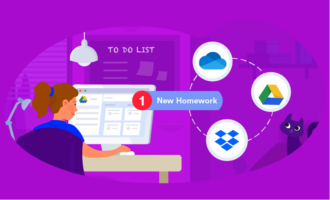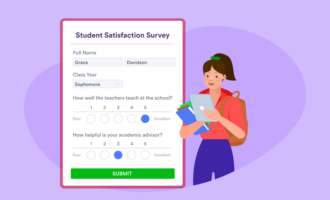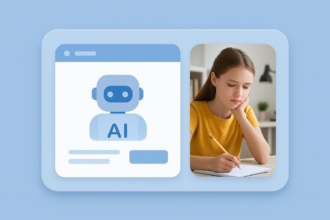Technology is constantly changing and pushing classrooms forward. While exciting, it can often leave teachers feeling overwhelmed rather than better equipped. Teachers can streamline repetitive, administrative tasks by using tech tools, but just how much time do they really save?
The short and sweet answer: It depends. The longer answer has to do with how teachers use tech both in and out of the classroom and which tools they choose to use. The simpler the better, it seems.
Pro Tip
Collect online quizzes, tests, surveys, and homework assignments from students for free with Jotform!
What educators have to say about technology
Many people like to point out how technology has changed the classroom, yet leaders in edtech don’t offer much proof to back that up. Martin Weller, who teaches educational technology at The Open University, writes that “amid this breathless attempt to keep abreast of new developments, the edtech field is remarkably poor at recording its own history or reflecting critically on its development.” Yes, technology is changing and has the potential to change the classroom, but unfortunately in edtech, the tech often comes before the ed.
Leaders try to apply technology built for other industries to the classroom, yet schools and teachers are often slow to adopt new tech features. There have certainly been major changes, but at the same time Weller points out that “nothing much has changed, and many edtech developments have failed to have significant impact.” Little is recorded statistically about the impact of new technology in the classroom, so what do teachers say?
Teachers tend to stick to simple tools that save them time. In a roundtable podcast hosted by educational consultant Angela Watson, several teachers talked about their favorite tools. Some cited specific apps for teachers, like Bloomz, or learning management systems, but most rely on free tools available to everybody, including Google Docs, Pinterest, and email.
“I rarely print a resource and put in my permanent files, until I’ve successfully used it,” explains teacher Nicole Guzman. “Otherwise, it ends up becoming clutter. Instead, I use the Kami extension to easily add files to my Google Drive, organized by subject and subtopic. I also bookmark websites organized by subject and topic.” Less time spent printing lesson plans and organizing physical folders means more time for lesson prep in the immediate future.
And teachers stick to simple-to-use tools for a reason: They’re quick to implement. Otherwise, teachers can face significant challenges when adopting new ways of doing things, writes Brendon Hyndman, Ph.D., senior lecturer and course director at Charles Sturt University. Challenges include the technology itself and whether training exists to support teachers, as well as expectations on the part of students and their parents.
Educator Brittany Washburn adds that teachers can find it difficult to keep up with technology because it changes so quickly. Teachers might feel that as soon as they’re comfortable using new systems in the classroom, they find out their students are way ahead of them. Still, she says the learning curve can be worth the effort, because ultimately good tools do save time and improve teaching outcomes.
Pro Tip
For an insightful look into the future of higher education, explore “8 Top Trends in Higher Education to Watch in 2024” on Jotform’s blog.
The right tools at the right time
Technology that is helpful and saves time keeps it simple — and meets a real need that teachers have. For example, apps that allow teachers to take attendance with a few swipes or make parent-teacher communication easier are tools that help teachers save time. These are tasks that would have taken much more manual work in the past, such as physically taking attendance sheets to the office or sending home handwritten notes in a student’s backpack (sometimes multiple times before actually being delivered).
The benefit of using tech tools in the classroom is obvious, says teacher Bethany Petty. Teachers are able to reduce the amount of time wasted on administrative tasks, increasing instruction time. Elementary teacher Marcee Harris says Google Keep is one of her favorite tools to keep notes and to-do lists organized. It can be used to collaborate with other teachers, keep tips for lesson plans bookmarked, and organize to-do lists (with alerts) in one space.
Online digital forms are some of the simplest tools that can save teachers time. Online forms enable teachers to create student polls, assessments, or teacher feedback forms quickly. There is no need to print each form and then manually record responses — they can be collected automatically and recorded online.
Choose technology that enables
Educators don’t have to know how to use every new tool on the market, but they should be intentional about the technology they do use.
Teachers can determine which technology is worth the time and money by thinking about what will most impact their class and their students. “The learning context has everything to do with whether or not technology is an enabler or an obstacle,” explains Shawn Mahoney, Ph.D., at McGraw-Hill. “The learning context must drive the thoughtful implementation of purposeful technology.” Technology will not be a burden to teachers — if it has purpose.






































































































Send Comment: